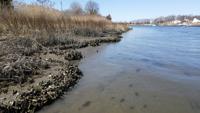LEWES, DE -- Leaders with the Delaware Department of Natural Resources and Environmental Control (DNREC) hosted the first day of their annual living shorelines workshop Tuesday. Attendees learned about the eco-friendly shoreline stabilization option.
According to DNREC officials, a living shoreline is an eco-friendly way to reduce erosion and mitigate flooding along Delaware's waterways.
Olivia Allread, outreach coordinator with DNREC's wetland monitoring and assessment program, said anywhere experiencing increased flooding or erosion due to climate change or rising sea levels could benefit from the stabilization option.
"We ask, 'How can we restore to its most natural way that it was?" Allread said. "Granted, it's never going to be the same, but we wanna mimic that as best as we can from an ecological standpoint."
Allread said some methods to mimic that include oyster castles, or incorporating native plants or animals into the habitat.
DNREC Environmental Scientist Alison Rogerson said living shorelines also help to maintain habitats and improve water quality.
"You can choose other alternatives like rip rap, bulkhead, or sea walls," Rogerson said. "But, in the long run, those options have their own issues with scouring or actually making water quality and erosion issues worse."
Rogerson said some of Delaware's waterways could use the makeover.
"We have a big shoreline problem in Delaware," Rogerson said. "We have a big population, we have a growing population, and we love to live right on the coasts. But we have a lot of environmental changes going on."
DNREC leaders will continue the workshop through Wednesday, March 25th. Those interested in learning more about living shorelines can visit DNREC's website.


